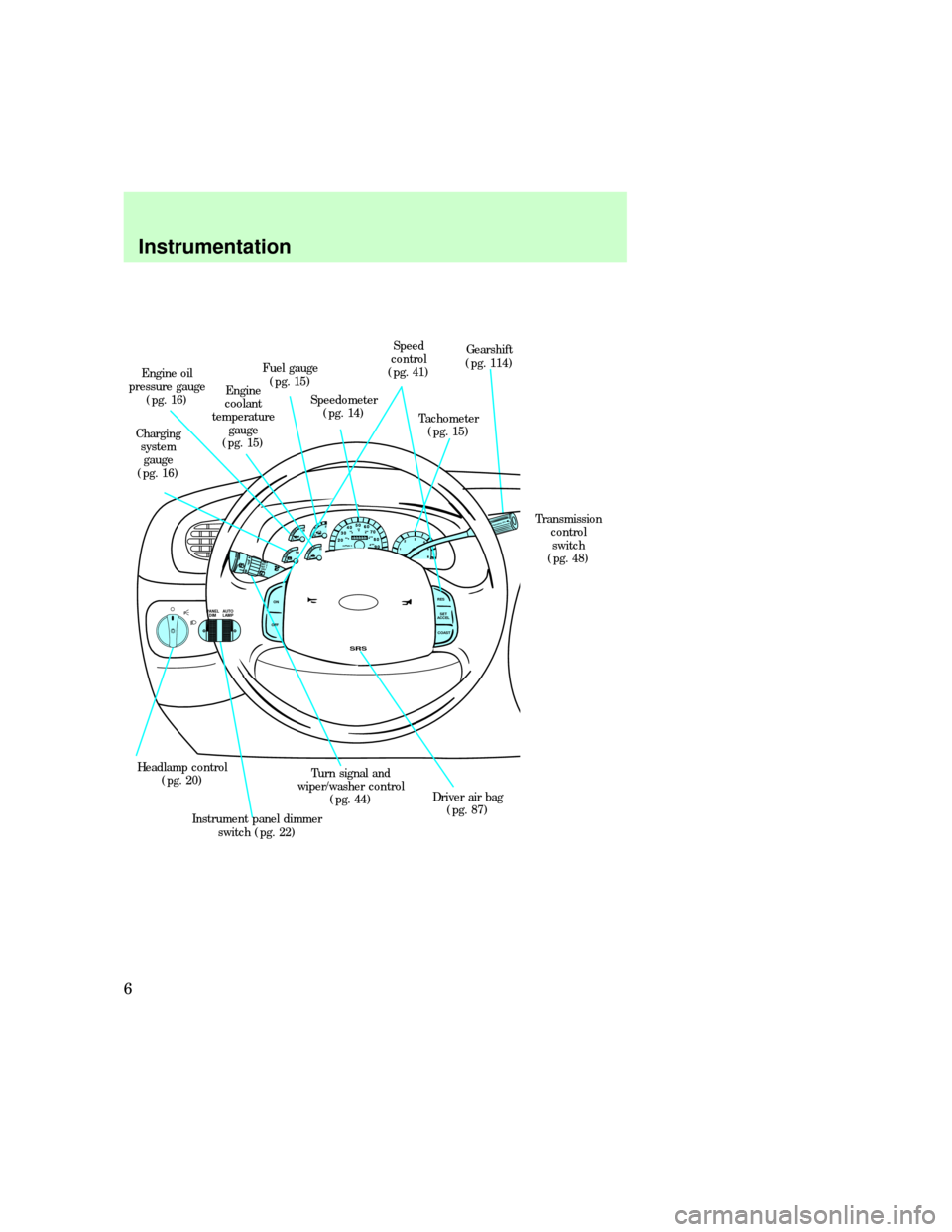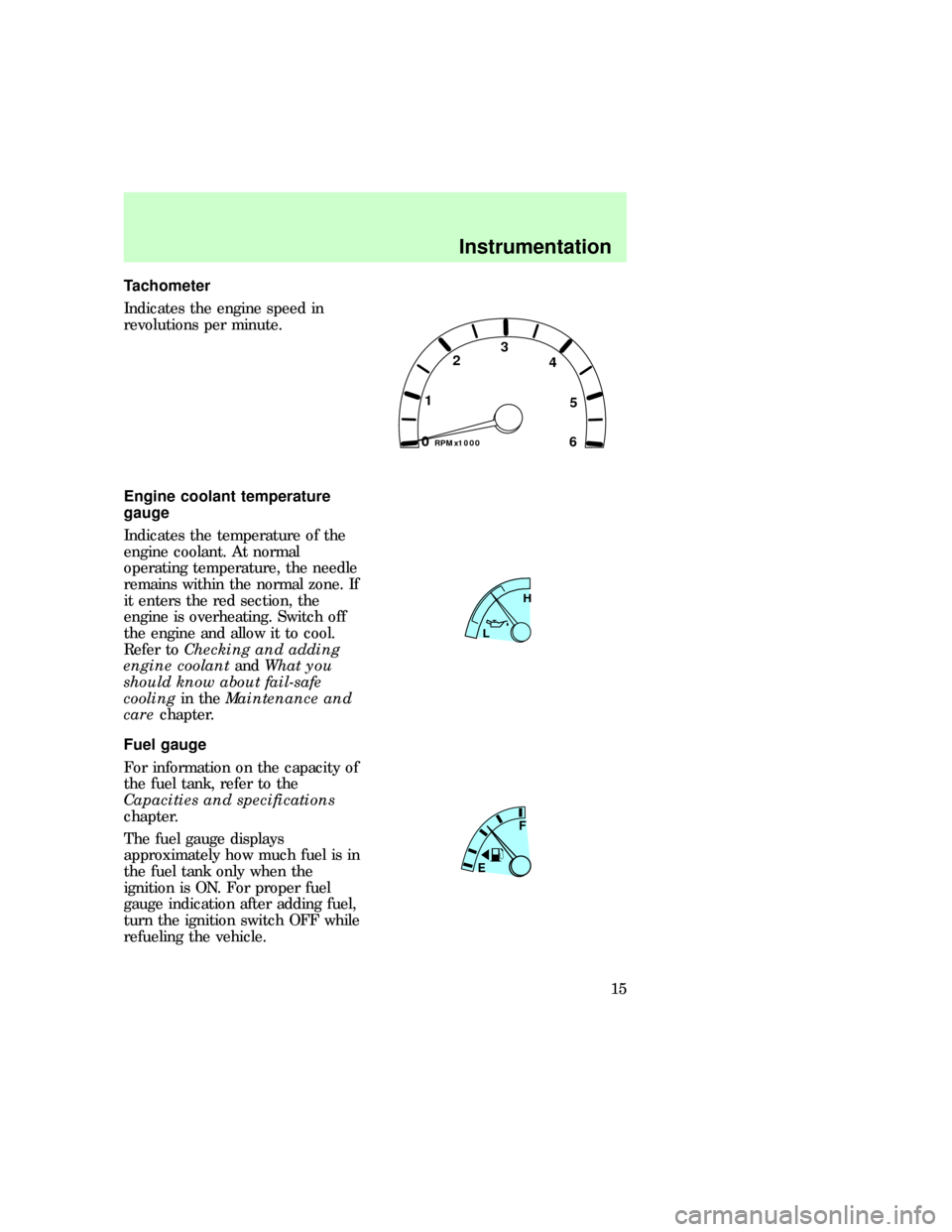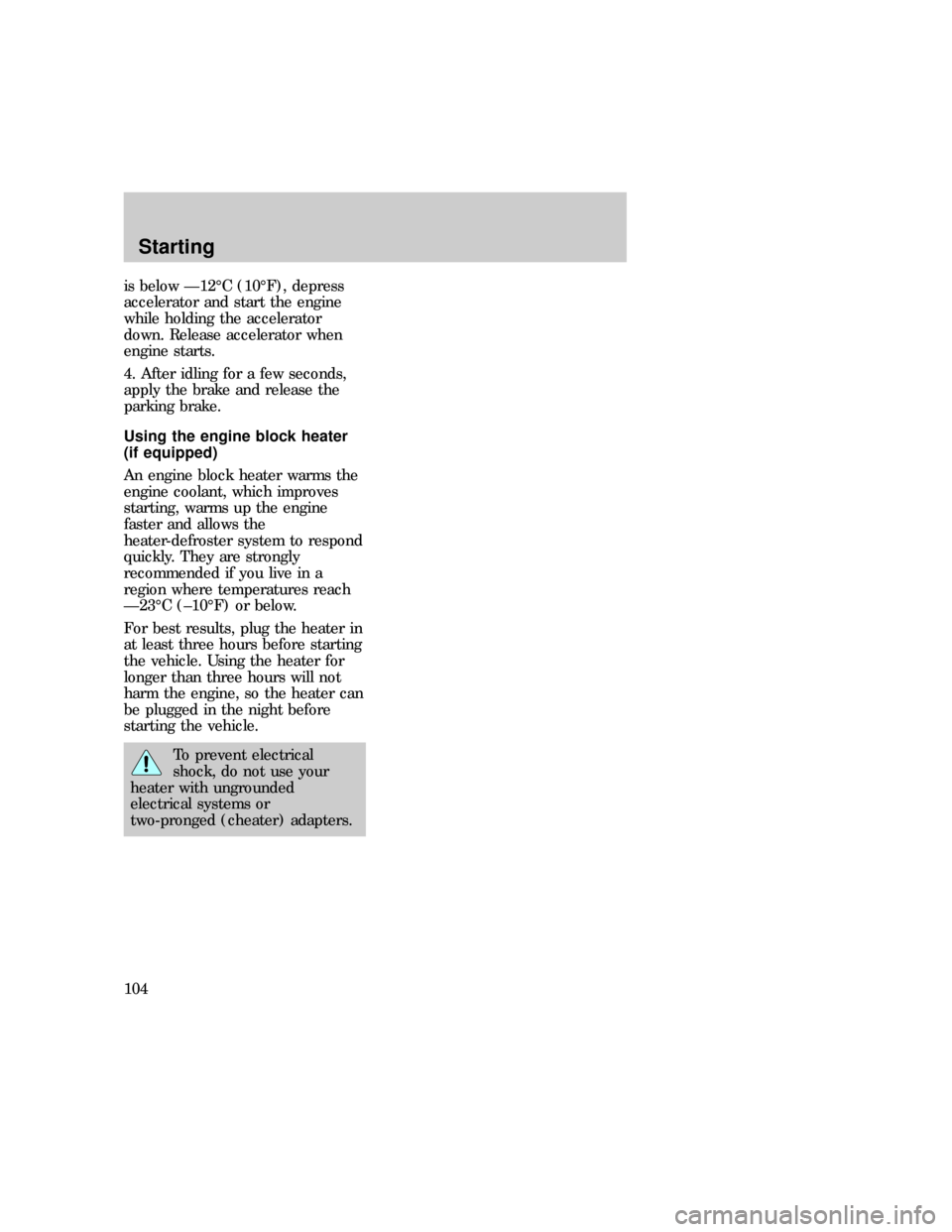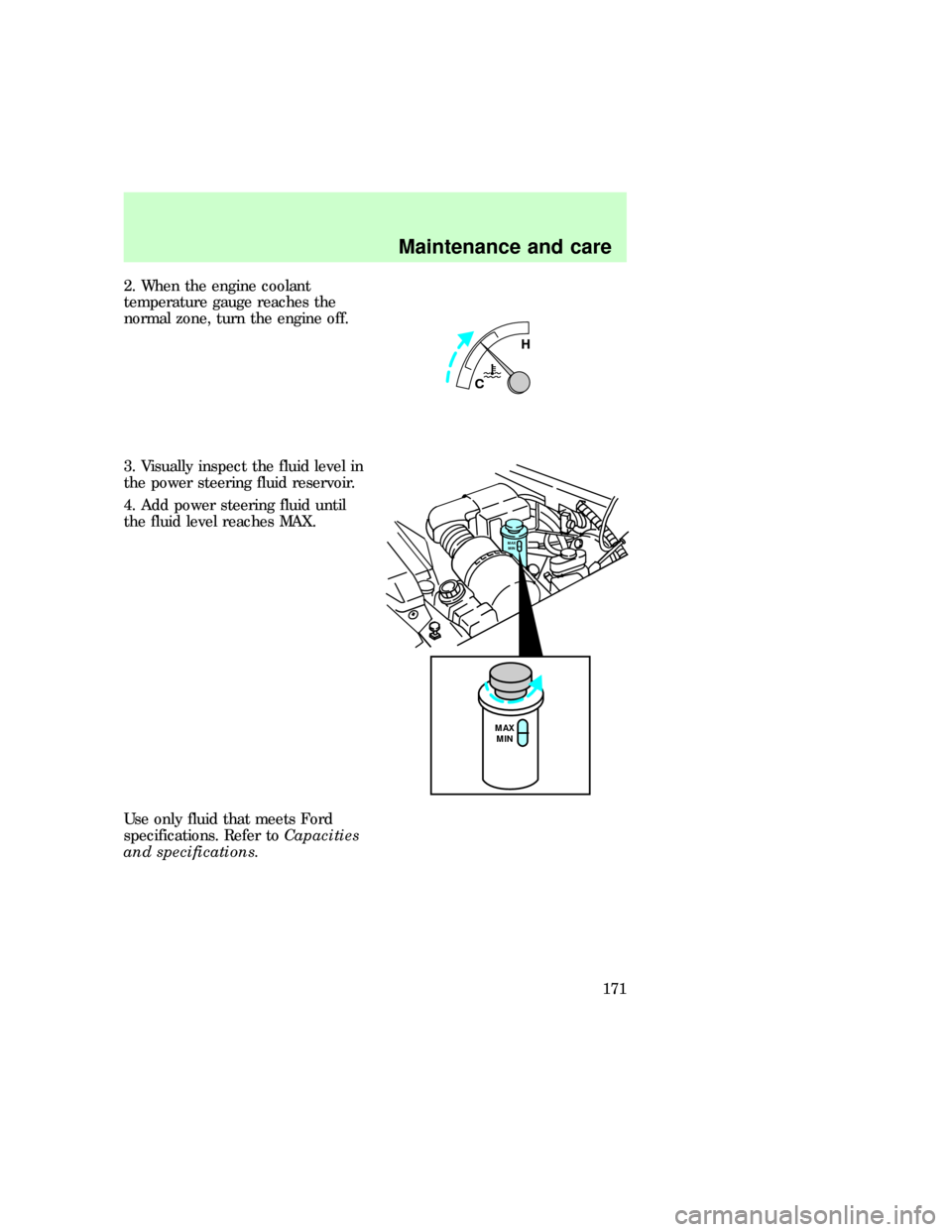coolant temperature FORD EXPEDITION 1997 1.G Owners Manual
[x] Cancel search | Manufacturer: FORD, Model Year: 1997, Model line: EXPEDITION, Model: FORD EXPEDITION 1997 1.GPages: 224, PDF Size: 2.2 MB
Page 5 of 224

350
30704080
120
14040
20
90 60
806010020 km/h0000052
4
5
6 1LHEF350
30704080
120
14040
20
90 60
806010020 km/h0000052
4
5
6 1LHEFNORMAL
PON
OFFRES
SET
ACCEL
COAST
INT 2
INT 1
OFF
OVERDRIVE OFF
PANEL
DIMAUTO
LAMP
CH818CH818NORMALNORMAL
SRS
Engine oil
pressure gauge
(pg. 16)Engine
coolant
temperature
gauge
(pg. 15)Fuel gauge
(pg. 15)
Speedometer
(pg. 14)Speed
control
(pg. 41)
Tachometer
(pg. 15)Gearshift
(pg. 114)
Transmission
control
switch
(pg. 48)
Driver air bag
(pg. 87) Turn signal and
wiper/washer control
(pg. 44)
Instrument panel dimmer
switch (pg. 22) Headlamp control
(pg. 20) Charging
system
gauge
(pg. 16)
Instrumentation
6
Page 7 of 224

INSTRUMENT CLUSTER
WARNING LIGHTS AND
CHIMES
Your vehicle is equipped with the
following instrument cluster:
Low fuel
Illuminates when the fuel level is
low.
Engine coolant temperature
Illuminates briefly when the
ignition key is turned to On.
Illuminates when the engine
coolant temperature is high. Stop
the engine and check the engine
coolant level as soon as possible.
Refer toChecking and adding
engine coolantandWhat you
should know about fail-safe
coolingin theMaintenance and
caresection.
3
1050
3070
4080
120
140
40
20
0
10090 60
8060100
20 km/h
0010
0000052
4
5
6 01LH
CH
EF
818
THEFT
RPMx1000LOW
RANGE
4x4 FUEL
RESET CHECK
ENGINEABS
DOOR
AJARLOW
FUEL3
1050
3070
4080
120
140
40
20
0
10090 60
8060100
20 km/h
0010
0000052
4
5
6 01LH
CH
EF
818
THEFT
RPMx1000ABS
BRAKELOW
FUEL!
LOW
FUEL
exd_warning_lights
exd_fuel_low
exd_coolant_light
exd_washer_low
Instrumentation
8
Page 14 of 224

Tachometer
Indicates the engine speed in
revolutions per minute.
Engine coolant temperature
gauge
Indicates the temperature of the
engine coolant. At normal
operating temperature, the needle
remains within the normal zone. If
it enters the red section, the
engine is overheating. Switch off
the engine and allow it to cool.
Refer toChecking and adding
engine coolantandWhat you
should know about fail-safe
coolingin theMaintenance and
carechapter.
Fuel gauge
For information on the capacity of
the fuel tank, refer to the
Capacities and specifications
chapter.
The fuel gauge displays
approximately how much fuel is in
the fuel tank only when the
ignition is ON. For proper fuel
gauge indication after adding fuel,
turn the ignition switch OFF while
refueling the vehicle.
0RPMx1000
3
2
4
5
6 1
LHLH
EF
exd_engine_coolant
exd_fuel_gauge
Instrumentation
15
Page 103 of 224

is below Ð12ÉC (10ÉF), depress
accelerator and start the engine
while holding the accelerator
down. Release accelerator when
engine starts.
4. After idling for a few seconds,
apply the brake and release the
parking brake.
Using the engine block heater
(if equipped)
An engine block heater warms the
engine coolant, which improves
starting, warms up the engine
faster and allows the
heater-defroster system to respond
quickly. They are strongly
recommended if you live in a
region where temperatures reach
Ð23ÉC (±10ÉF) or below.
For best results, plug the heater in
at least three hours before starting
the vehicle. Using the heater for
longer than three hours will not
harm the engine, so the heater can
be plugged in the night before
starting the vehicle.
To prevent electrical
shock, do not use your
heater with ungrounded
electrical systems or
two-pronged (cheater) adapters.
com_engine_heater.01
com_ventilation_info.01
Starting
104
Page 167 of 224
![FORD EXPEDITION 1997 1.G Owners Manual Severe winter climate
If you drive in extremely cold
climates [less than 36ÉC (34ÉF)], it
may be necessary to increase the
coolant concentration above 50%.
Refer to the chart on the coolant
containe FORD EXPEDITION 1997 1.G Owners Manual Severe winter climate
If you drive in extremely cold
climates [less than 36ÉC (34ÉF)], it
may be necessary to increase the
coolant concentration above 50%.
Refer to the chart on the coolant
containe](/img/11/4905/w960_4905-166.png)
Severe winter climate
If you drive in extremely cold
climates [less than 36ÉC (34ÉF)], it
may be necessary to increase the
coolant concentration above 50%.
Refer to the chart on the coolant
container to ensure the coolant
concentration in your vehicle is such
that the coolant will not freeze at
the temperature level in which you
drive during winter months. Never
increase the engine coolant
concentration above 60%. Leave a
50/50 mixture of engine coolant and
water in your vehicle year-round in
non-extreme climates.
Checking the cooling system
hoses
Inspect all engine and heater system
hoses and hose connections for:
com_checking_hoses.01
Maintenance and care
168
Page 168 of 224

²deterioration
²leaks
²loose hose clamps
What you should know about
fail-safe cooling
Vehicles equipped with 4.6L, and
5.4L engines have a fail-safe
cooling mode. If the engine coolant
supply is depleted, this feature
allows the vehicle to be driven
temporarily before incremental
component damage is incurred.
The ªfail safeº distance depends on
ambient temperatures, vehicle load
and terrain.
When fail-safe mode is
activated
²Pull off the road as soon as
possible.
²Immediately turn the engine off
to prevent severe engine
damage.
²Wait for the engine to cool.
²Check the coolant level.
exd_failsafe_cooling
com_activated_failsafe.01
exd_how_failsafe
Maintenance and care
169
Page 169 of 224

How fail-safe cooling works
If the engine overheats, the engine
will automatically switch from
eight to alternating four cylinder
operation. Each disabled cylinder
acts as an air pump and cools the
engine.
When this occurs, the engine
coolant temperature gauge will
move into the red area and the
light illuminates.
The service engine soon light will
illuminate, indicating that vehicle
service is required.
The vehicle will still operate, but
will have limited engine power and
no air conditioning capability.
Continued operation will increase
engine temperature and cause the
engine to completely shut down.
The vehicle will coast to a stop.
As the engine temperature cools,
the engine may be re-started. Take
your vehicle to a service facility as
soon as possible to minimize
engine damage.
CHECKING AND ADDING
POWER STEERING FLUID
Check the power steering fluid
level at least twice a year.
1. Start the engine.
CH
exd_power_steering
Maintenance and care
170
Page 170 of 224

2. When the engine coolant
temperature gauge reaches the
normal zone, turn the engine off.
3. Visually inspect the fluid level in
the power steering fluid reservoir.
4. Add power steering fluid until
the fluid level reaches MAX.
Use only fluid that meets Ford
specifications. Refer toCapacities
and specifications.
CHCH
MAX
MIN
MAX
MIN
exd_trans_fluid
Maintenance and care
171
Page 215 of 224

Item Ford part nameFord part
numberFord
specification
Driveshaft, slip
sline, double
Carden joint
center ballPremium Long
Life GreaseXG-1-C ESA-M13P4-A
Door
weather-stripsSilicone
LubricantsCOAZ-19553-AA
AND
D7AZ-19553-AAESR-M13P4-A
Engine coolant Ford Premium
Cooling System
FluidE2FZ-19549-AA ESE-M97B44-A
Steering linkage Premium Long
Life GreaseXG-1-C ESA-M1C75-B
Engine oil Motorcraft Motor
Oil 5W30 Super
PremiumXO-5W30-QSP WSS-M2C153-F
with API
Certification
Mark
4x4 front wheel
bearings, 4x4
spindle needle
bearings,
spindle thrust
bearings & front
drive axle
u-joint/slip slineHigh
Temperature
4x4 Front Axle
& Wheel
Bearing GreaseE8TZ-19590-A ESA-M1C198-A
Automatic
transmissionMotorcraft
MERCONT
Automatic
Transmission
Fluidxt-2-qdx MERCONT
Power steering
reservoirPremium Power
Steering FluidE6AZ-19582-AA ESW-M2C33-F
Capacities and specifications
216